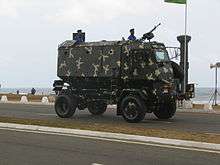Unicorn APC
| Unicorn | |
|---|---|
|
A Unicorn used by the Sri Lankan Army | |
| Type | Armoured personnel carrier |
| Place of origin | Sri Lanka |
| Service history | |
| In service | 1987 - Present |
| Used by | Sri Lanka |
| Production history | |
| Designer | Sri Lanka Electrical and Mechanical Engineers[1] |
| Manufacturer | Sri Lanka Electrical and Mechanical Engineers[1] |
| Produced | 1987 - 2000 |
| Variants | Mark I to Mark VI |
| Specifications | |
| Weight | 5.8 t |
| Length | 4.8 m (16.73 ft) |
| Width | 2 m (6.73 ft) |
| Height | 2.6 m (9.68 ft) |
| Crew | 2 + 12 passengers |
|
| |
| Armor | Classified |
Main armament | Twin 7.62mm MG (front) |
| Engine | Diesel Engine |
| Suspension | 4×4 wheeled |
| Speed |
Road 96km/h (59.61 mph) Off-road 30km/h (18.64 mph) |
The Unicorn is a MRAP used by the Sri Lankan military based on the Buffel.
Production history
Initial research into producing a "Blast Protected Vehicle" armoured personnel carrier was begun in 1983 by a lone Infantry Major named Jayantha de Silva who was concerned by the destruction wrought by Improvised Explosive Devices (IEDs) that the Tamil rebels began using on military troop transport vehicles. These IEDs became rampant in the north and eastern provinces with the escalation of the Sri Lankan Civil War. The many experiments he carried out showed that explosive force dissipates in proportions to the distance travelled. These led to the production of vehicles based on commercial truck chassis with a strong metal hull about two metres from ground level. These proved so successful that the then Minister for National Security, Hon Lalith Athulathmudali, co-opted all the engineering firms in the country to build the vehicles to the specifications drafted by Major de Silva. The project was then handed over to the Electrical and Mechanical Engineers of the Army.
When the rebels found that their IEDs were ineffective, they stopped using them and the production of these vehicles ceased. The rebels began using them again about two years later, and as the Army found itself short of suitable vehicles, a few consignments of the South African made Buffel vehicles were imported, even though they provided protection only against land mines and proved ineffective against the IEDs. Further development continued in 1985, by both the Sri Lanka Electrical and Mechanical Engineers (SLEME) of the Sri Lanka Army[2] and the General Engineering Wing of the Sri Lanka Air Force[3] Both designs were based on the South African Buffels which had been bought in 1985.[4]
The air force developed its own APC for the SLAF Regiment in small numbers. The SLEME developed the Unicorn Mark I by 1987, which too where produced in large numbers by the SLEME for the Sri Lanka Army and for the other services as well.
A distinct feature of the Unicorn was that the driver-passenger compartment was undivided. According to soldiers in the battlefield, this feature made communication among the two sections easier than that in a Buffel where the driver was separated from the passengers.
Variants
There were several models that were developed as a result of continuous upgrading based on combat requirements. These include Unicorn Mark I to Mark VI. Production continued until 2000 with a total of 93 Unicorns being produced by the SLEME with the Mark VI being produced.[2] The production of the Unicorn Mark VI was stopped when the SLEME started producing the more advanced Unibuffel.
Operators

References
- 1 2 59th Independence. Retrieved on April 22, 2008.
- 1 2 The evolution of the indigenous armoured vehicle: From Unicorn to Unibuffel Retrieved on April 22, 2008
- ↑ Sri Lanka Air Force. Retrieved on April 22, 2008.
- ↑ Camp & Heitman, p. 239
Further reading
- Surviving the Ride: A Pictorial History of South African-Manufactured Mine-Protected Vehicles by Steve Camp & Helmoed Römer Heitman
